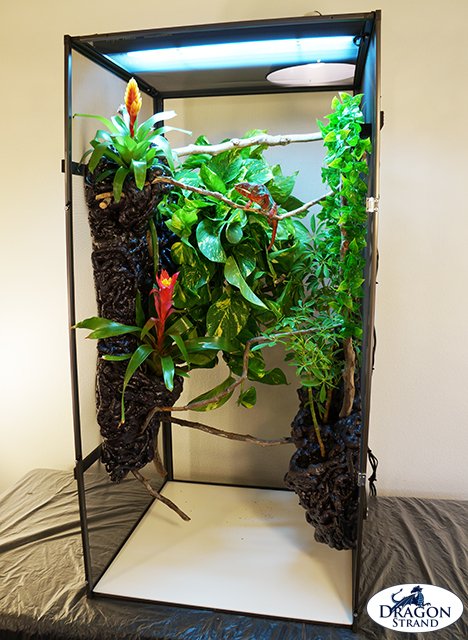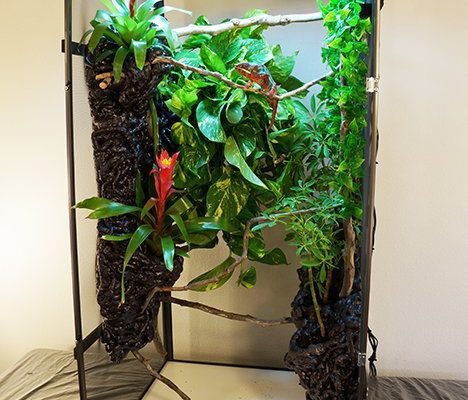
A great enclosure setup goes beyond just walls; it’s about creating an ecosystem. Parson’s chameleons thrive when they feel like they’re part of the lush vegetation they come from, so it’s essential to consider their specific needs. Let’s dive into the different aspects of an ideal enclosure to ensure your chameleon feels right at home.
Choosing the Right Size Enclosure
When it comes to the size of the enclosure, bigger is definitely better. Parson’s chameleons are quite large compared to other chameleon species, so you’ll want an enclosure that gives them plenty of room to explore. A minimum size for an adult Parson’s chameleon is around 4 feet tall, 2 feet wide, and 2 feet deep. The vertical height is crucial because these little guys love to climb.
Imagine living in a tiny room with nothing but a mattress—pretty dull, right? Now think of a spacious tree where you can roam freely. That’s what a larger enclosure provides for your chameleon. Plus, it gives you the ability to create layers, with lots of branches and foliage at different heights. This setup promotes exercise and helps your chameleon feel secure.
Material and Type of Enclosure
What you use to build the enclosure matters just as much as the size. Most reptile owners choose between glass terrariums and screen cages. Each comes with its own pros and cons. A glass terrarium can help maintain humidity, which is vital for Parson’s chameleons. However, it might limit airflow, so proper ventilation is key.
On the other hand, screen enclosures provide excellent airflow, which can help prevent mold and bacteria growth. They also allow for easy access to your chameleon and make the enclosure lighter. If you opt for a screen cage, ensure it has a waterproof base to hold the substrate and any water you might use for humidity. Think of it like choosing between a cozy apartment and a breezy beach house—both have their own charm!
Substrate Choices
The substrate at the bottom of the enclosure is like the floor of your chameleon’s home. It needs to be safe and easy to clean. Many chameleon owners prefer hygienic substrates like reptile carpet, paper towels, or coconut coir. These materials are easy to maintain and can help prevent impaction if ingested.
You might be wondering about using soil or sand. While they can look great, they come with risks. Soil can harbor pests, and sand can cause health issues if your chameleon accidentally ingests it. All in all, keeping it simple usually wins when choosing your substrate.
Creating Climbing Spaces
Chameleons are arboreal, meaning they love to climb. This is where you can get creative! Adding branches, vines, and logs can make your enclosure a jungle gym. You can use natural branches from non-toxic trees (like oak or manzanita) or purchase artificial ones designed for reptile setups.
Here’s the thing: make sure to arrange these climbing structures at various heights. This gives your chameleon options and allows it to exhibit its natural behavior. Just picture your chameleon lounging on a branch, soaking up the light, and enjoying its environment. It not only keeps them active but also reduces stress.
Heat and Lighting Needs
Getting your light and heat setup right is crucial for a happy chameleon. A solid UVB bulb helps your chameleon synthesize vitamin D3, which is vital for calcium absorption. Look for bulbs designed specifically for reptiles, usually available in pet stores. You’ll want to place this light near the basking area, along with a heat lamp that mimics the sun’s warmth.
When setting up, ensure you have a cool side and a warm side in the enclosure. This gradient allows your chameleon to move and regulate its body temperature. A basking spot of around 85-90°F (29-32°C) is ideal, while the cooler side should be about 70-75°F (21-24°C). Think of it like creating a sunny beach and a shady tree—your chameleon can choose where to hang out based on how it feels.
Humidity and Water Requirements
Humidity is a big deal for Parson’s chameleons. They thrive in environments with around 50-70% humidity. To achieve this, regular misting is essential. You might consider using a misting system or a hand-held spray bottle to create that tropical atmosphere. Misting not only helps keep humidity levels up but also provides drinking water.
You should also offer a shallow bowl of water, but be cautious. Many chameleons prefer to drink droplets from leaves rather than standing water. Misting can help mimic this natural behavior. Just imagine how refreshing a little rain feels on a hot day—your chameleon will appreciate it too.
Decor and Planting Options
Adding live plants creates a more natural feel and can boost the humidity! Consider adding non-toxic plants like pothos, spider plants, or ferns. Not only do they provide hiding spots and climbing opportunities but they also contribute to a healthier environment by helping to regulate humidity and purify the air.
Position plants at different levels within the enclosure to enhance the climbing experience. You can even create a little jungle for your chameleon! Just be sure to check if any plants are safe for reptiles before you add them. It’s like making sure your new roommates are friendly—it saves some headaches later!
In conclusion, setting up the best enclosure for a Parson’s chameleon takes a bit of thought, creativity, and care. You’ll want to focus on size, materials, climbing opportunities, temperature, humidity, and decor to create a thriving home for your new friend. Each element plays a role in keeping them happy, healthy, and vibrant. Just visualize their little world, and you’ll be on your way to creating a stunning habitat that your chameleon will love!

